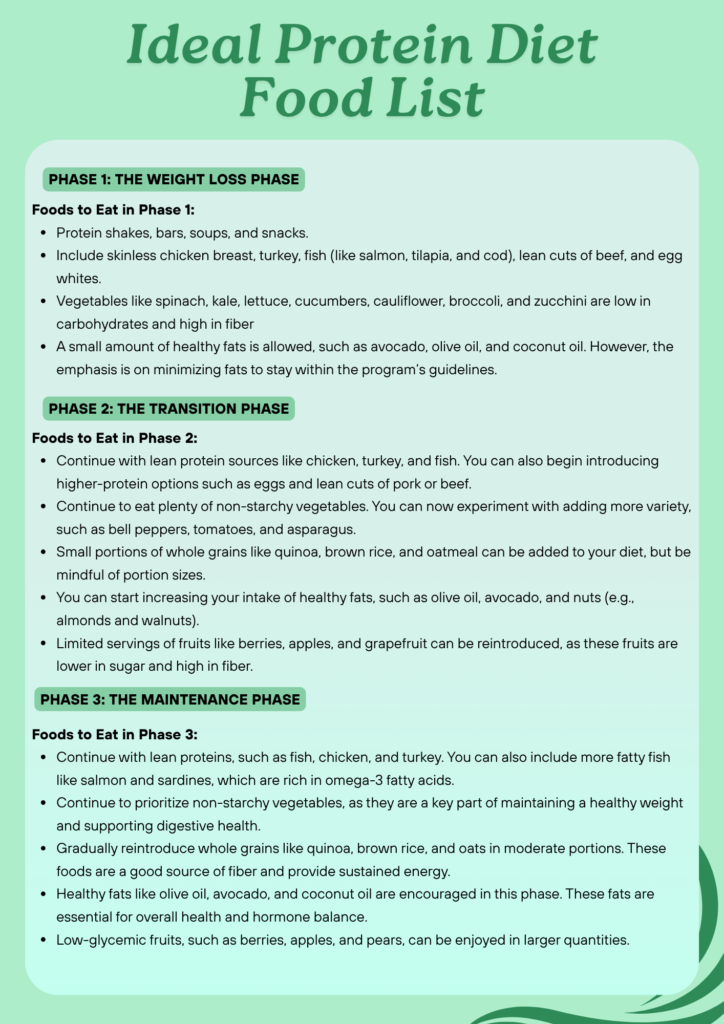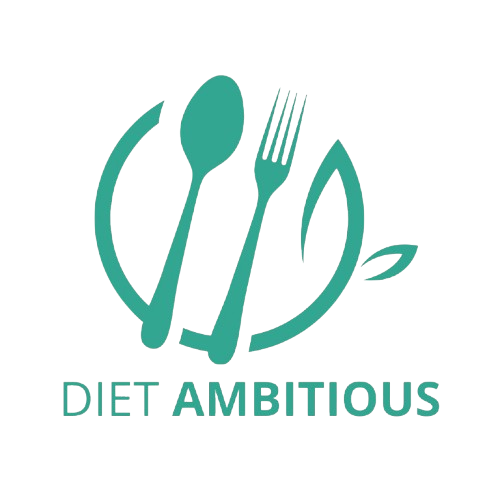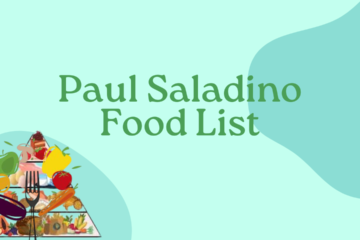The Ideal Protein Diet is a medically designed weight loss protocol that focuses on reducing body fat while preserving lean muscle mass. This structured plan is divided into phases, with specific guidelines on the types of foods you can eat during each phase. The goal of the Ideal Protein Diet is to help individuals lose weight by following a high-protein, low-carbohydrate, and low-fat approach, with an emphasis on balanced nutrition to support long-term health.
This article will provide an overview of the Ideal Protein Diet food list, broken down by phase, to help you understand which foods to include and avoid while following the plan.
Table of Contents
Phase 1: The Weight Loss Phase
The first phase of the Ideal Protein Diet is focused on weight loss. During this phase, your body will primarily burn stored fat for energy while you consume high-quality proteins, minimal carbohydrates, and healthy fats. The goal is to reduce body fat while maintaining muscle mass.

Foods to Eat in Phase 1:
- Ideal Protein Foods: The program offers a variety of pre-packaged, high-protein foods such as protein shakes, bars, soups, and snacks. These are designed to provide essential nutrients while limiting calories and carbohydrates.
- Lean Proteins: Include skinless chicken breast, turkey, fish (like salmon, tilapia, and cod), lean cuts of beef, and egg whites. These proteins help to keep you feeling full and support muscle repair.
- Non-Starchy Vegetables: Vegetables like spinach, kale, lettuce, cucumbers, cauliflower, broccoli, and zucchini are low in carbohydrates and high in fiber, making them ideal for weight loss.
- Healthy Fats (in moderation): A small amount of healthy fats is allowed, such as avocado, olive oil, and coconut oil. However, the emphasis is on minimizing fats to stay within the program’s guidelines.
Foods to Avoid in Phase 1:
- Carbohydrates: Foods like bread, pasta, rice, potatoes, and sugary fruits should be avoided, as they are high in carbohydrates and can disrupt the ketosis process.
- Dairy Products: Full-fat dairy and sugary dairy products like cheese, yogurt, and milk should be limited or avoided in this phase.
- Processed Foods: Processed snacks, packaged sweets, and high-sugar beverages should be avoided to stay within the allowed nutritional guidelines.
Phase 2: The Transition Phase
Phase 2 is the transition phase where you begin reintroducing certain foods to your diet. The goal of this phase is to help you maintain your weight loss while transitioning to a more sustainable, balanced eating plan.
Foods to Eat in Phase 2:
- Lean Proteins: Continue with lean protein sources like chicken, turkey, and fish. You can also begin introducing higher-protein options such as eggs and lean cuts of pork or beef.
- Non-Starchy Vegetables: Continue to eat plenty of non-starchy vegetables. You can now experiment with adding more variety, such as bell peppers, tomatoes, and asparagus.
- Whole Grains (in moderation): Small portions of whole grains like quinoa, brown rice, and oatmeal can be added to your diet, but be mindful of portion sizes.
- Healthy Fats: You can start increasing your intake of healthy fats, such as olive oil, avocado, and nuts (e.g., almonds and walnuts).
- Low-Sugar Fruits: Limited servings of fruits like berries, apples, and grapefruit can be reintroduced, as these fruits are lower in sugar and high in fiber.
Foods to Avoid in Phase 2:
- High-Sugar Fruits: Fruits like bananas, grapes, mangoes, and pineapples should still be avoided as they are higher in sugar and carbohydrates.
- Processed Carbs: Foods like white bread, pasta, and chips should be minimized or avoided.
Phase 3: The Maintenance Phase
Phase 3 is the maintenance phase, where you have reached your goal weight and now aim to maintain it. In this phase, you will continue to focus on balanced nutrition and portion control, incorporating a variety of foods into your diet.
Foods to Eat in Phase 3:
- Lean Proteins: Continue with lean proteins, such as fish, chicken, and turkey. You can also include more fatty fish like salmon and sardines, which are rich in omega-3 fatty acids.
- Non-Starchy Vegetables: Continue to prioritize non-starchy vegetables, as they are a key part of maintaining a healthy weight and supporting digestive health.
- Whole Grains: Gradually reintroduce whole grains like quinoa, brown rice, and oats in moderate portions. These foods are a good source of fiber and provide sustained energy.
- Healthy Fats: Healthy fats like olive oil, avocado, and coconut oil are encouraged in this phase. These fats are essential for overall health and hormone balance.
- Low-Glycemic Fruits: Low-glycemic fruits, such as berries, apples, and pears, can be enjoyed in larger quantities.
Foods to Avoid in Phase 3:
- Sugary Snacks: Avoid sugary snacks and desserts, such as cakes, cookies, and ice cream, which can contribute to weight gain.
- Processed Carbs: Minimize your intake of processed carbs like white bread, pastries, and sugary cereals.
- Sugary Drinks: Avoid sugary beverages like soda, fruit juices, and sweetened teas.
Ideal Protein Diet Food List Summary
The Ideal Protein Diet focuses on high-protein, low-carb, and low-fat foods to promote weight loss and muscle preservation. It is divided into three phases, each with specific guidelines on the types of foods you can eat. The key foods to include are lean proteins, non-starchy vegetables, healthy fats, and whole grains (in moderation). Processed carbs, sugary foods, and high-fat dairy are to be avoided, especially in the early phases.
By following the Ideal Protein Diet food list and gradually incorporating a balanced, sustainable eating plan, you can work towards achieving and maintaining your weight loss goals.




